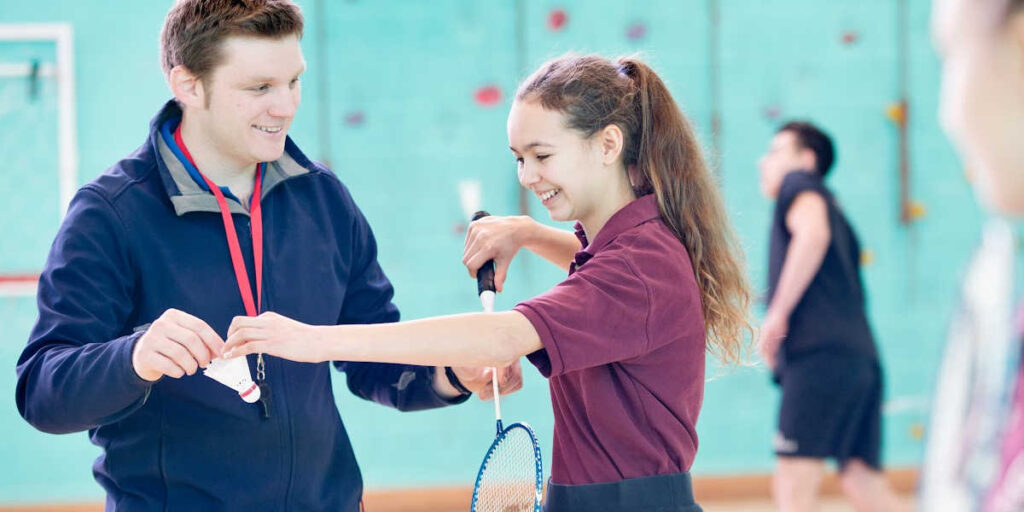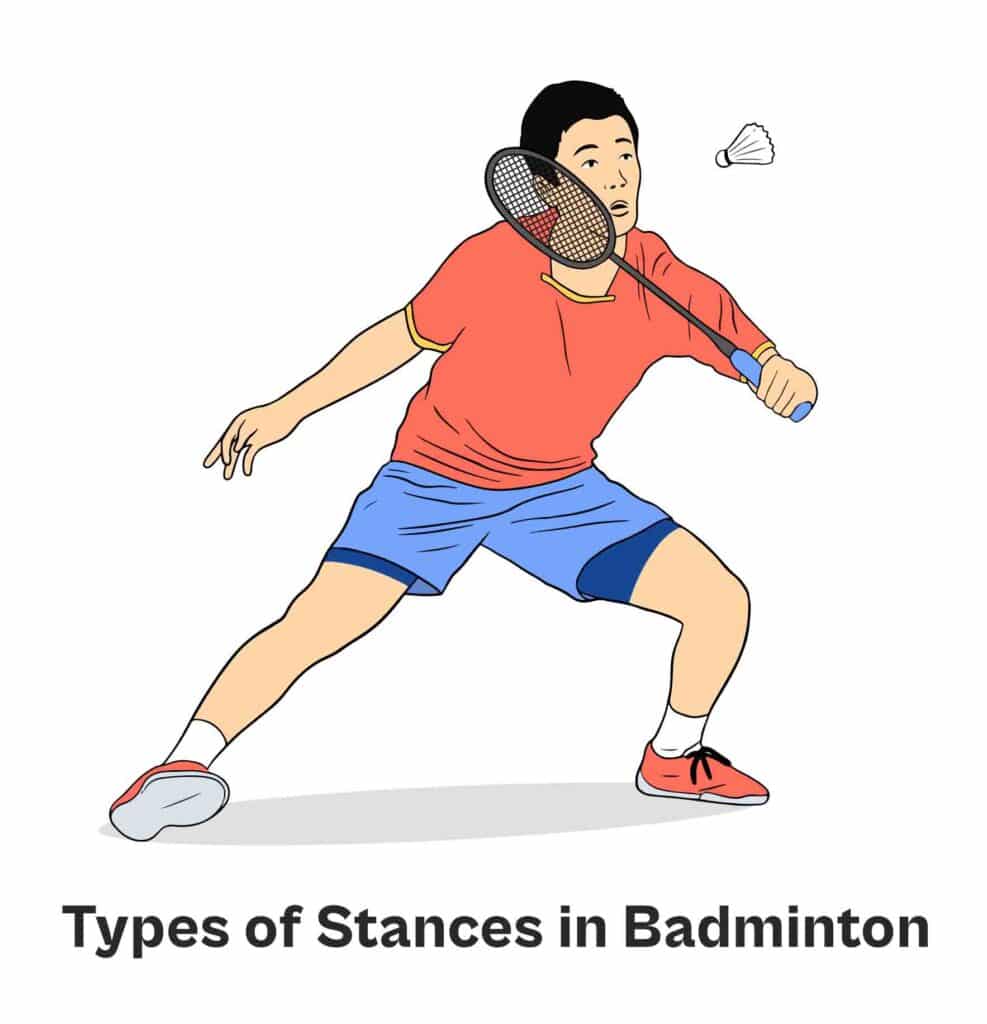You must have heard that badminton requires a combination of strategy, agility, and precision. With these in your grip, you can master the game.
But are those enough? No, you need to master some fundamental skills to excel in this game. I am dedicating this article to knowing those fundamental skills.
So, sit down, put your reading glasses on, and get ready to learn fundamental skills of badminton for beginners.

Mastering Your Grip
A grip in badminton is how you hold your racquet. There are four types of grip, two of which are commonly used.
- Forehand grip
- Backhand grip
- Bevel grip
- Panhandle grip

Your shot lies across the court based on how you hold your racquet.
If you are using the forehand grip, you can easily hit:
- Forehand clears
- Forehand smashes
- Forehand drops
- Forehand drives
- Forehand lifts
- Forehand net shots
If you are using the backhand grip, you can easily hit:
- Backhand net shots
- Backhand drives
- Backhand lifts
- Backhand serves
If you are using the bevel grip, you can easily hit:
- Backhand rear-court clears
- Backhand rear-court drops
- Backhand rear-court smashes
- Forehand net shots
- Backhand net shots
If you are using the panhandle grip, you can easily hit:
- Late backhand rear-court shots
- Net kills
- Drives

Importance of Stance
Stance is the way you stand while playing badminton. Most beginners ignore this fundamental badminton skill, and that’s a huge mistake. Because if you don’t assume the correct position, you are less likely to achieve the desired shot.

You must know that there are three types of stances in badminton:
- Attacking stance
- Defensive stance
- Net stance
As the name suggests, an attacking stance must be taken when you are attacking in a rally. This is usually assumed when your opponent lifts the shuttle or hits a clear shot up to you.
In a defensive stance, you must always assume the center court position because you never know which part of your court is going to be attacked. Be ready to move in all directions to defend your entire court when you are not attacking.
A net stance is usually assumed only while playing a net shot. Use this only when you are absolutely sure of an upcoming net shot.
Essential Footwork Movements
In badminton singles, you are responsible for covering the 22 x 17 feet court all by yourself. While in the doubles, you have a partner to share half a court. Irrespective of that, each player has a significant portion of the court to cover. And getting from one point to another becomes a huge task.
So, you can use certain footwork movements to speed up your movement.
- Scissors leaps
- Running steps
- Cross steps
- Lunges
- Split steps
- Chase steps
- Side steps
Mastering the Clear Shot
A clear shot in badminton is a shot hit from your baseline (back boundary of the court) to your opponent’s baseline. The aim of this shot is to make the opponent run to the back of the field. This is most effectively placed if your opponent is standing too close to the net. They will have difficulty running all the way to the back of the court in time.
There are two Types of Clear Shots – Defending and Attacking.
- In a defending clear, the shuttlecock is aimed to follow a high trajectory off the ground. It has to be high and deep.
- While an attacking clear can be placed at a lower height, it must be faster so your opponent doesn’t have time to react.
Mastering the Drop Shot
A drop shot in badminton aims to deceive your opponent into thinking that your next few shots are going to be in the frontcourt. You drop the shuttlecock just after the net to create space in the mid and backcourt. And as soon as your opponent is in the front court, hit your next shot in the backcourt. This will give your opponent very little time to cover the court area.
You can also make your opponent believe that you are playing a drive shot. So, they will position themselves at the backcourt to respond to that. But at the last moment, you change your hit and place a drop shot in the frontcourt. It will catch them off guard as they were expecting a drive in the backcourt.
Mastering the Smash
Smash is one of the most powerful shots in badminton. The shuttlecock is hit at a downward angle with high speed so the opponent doesn’t get a chance to lift it. The fastest record of a smash is by Satwiksairaj Rankireddy (male), who hit the shuttlecock at a speed of 565 km/hr.
While playing a smash, jump as high as you can. Use the full force of your swing. Always make contact with the shuttlecock above your head to get the correct angle. Give maximum focus on power instead of precision. Time your smash when your opponent is least expecting it – it’s a great shot to win a rally.
Essential Techniques for Forehand and Backhand Drives
A drive is a straight shot played horizontally across the court. It is usually played from midcourt to midcourt. The best time to hit a drive is when the shuttlecock is at a height between your shoulders and knees.
A drive can sometimes even be used just to catch a smash in its trajectory. If played well, a drive will force your opponent to do a lift. That will open you up to attack in your next shot.
There are two types of drive:
- Forehand drive
- Backhand drive
The major difference between these two is the grip. As the name suggests, use a forehand grip for the forehand drive and the backhand grip for the backhand drive.
Benefits of Badminton for Students
Mastering the Net Shot
A net shot is a delicate shot that lands softly just over the net. Aim this shot to land as close to the net as possible on your opponent’s side. It should preferably land at an awkward angle. This confuses the opponent who’s standing near the net expecting a mid-court shot.
The net shot is most effectively used in a doubles badminton game. One player plays a net shot and forces the opponent to lift it. Then, the other player uses that opportunity to gain an attacking advantage.
If your opponent is on the same side of the court as you, then you can try to do a cross-court net shot. For instance, both you and your opponent are on the right side of the court, then aim the net shots to land on the left side of the court. This won’t give your opponent time to reach the shuttlecock before it drops too low.

Forehand Stroke
Forehand stroke is the most basic method of playing a shot in badminton. You must hold the racquet in a forehand grip while playing a shot. You can adjust your final hit based on the shot you want to play (small, drive, etc.).
There are two types of forehand stroke: Underarm and overhead. In an underarm forehand stroke, the racquet must be swung upwards from below your waist. In an overhead forehand stroke, the racquet must be swung in the area between your shoulders and overhead.
Backhand Stroke
The theory behind backhand stroke is very similar to that of forehand stroke. The only difference between the two is that you use a backhand grip in a backhand stroke instead of the forehand grip.
The two types of strokes – underarm and overhead – remain the same in the forehand stroke.
Conclusion
Mastering these basic skills will build a strong foundation for your game. Consider them as building blocks of your gameplay. If any of these skills are a weak point, work on them because most experienced badminton players learn to find their opponent’s weakness and use it to their advantage. So, master these badminton fundamentals to be an excellent player.
Frequently Asked Questions
What kind of shoes should I wear for badminton?
Badminton requires quick movements and changes in direction, so you should get lightweight and non-marking badminton shoes. Remember, they should have good ankle support to provide optimal performance and prevent injuries.
How can I improve my grip strength for badminton?
You can improve your grip strength in badminton by doing exercises like wrist curls and grip squeezes. You can use tools like grip strengtheners for better results. Also, practice holding the racket for an extended period of time.
What is the best way to practice badminton skills alone?
The best way to practice badminton skills alone is against a wall. You can simulate different shots and footwork patterns without a shuttlecock at first and then with one. This will help improve accuracy and control.
What is the meaning of yellow, red, and black cards in badminton sport?
These are basically a type of rules penalties while playing badminton, Yellow card serves as a warning for rule violations like throwing the racket or cause unnecessary delays and incurs a monetary fine. Accumulate 2 yellow cards results in a Red Card, which means penalizes player by awarding a point to the opponent and to impose heavier fine and Black card is to issue for continued misconduct after a red card, that leads to disqualification from the tournament.
What should be the ideal weight of badminton racket?
Weight of the badminton racket is usually between 80g – 100g
More specifically:
– 4U (80-84g): Recommended for players who want speed and maneuverability.
– 3U: (85-89g): Balanced option for singles and doubles, combining power and control.
– 2U: (90-94g): Good choice for advanced players who value power and stability.
– 1U 95-100g: Used for power play or specific training.
For better control, beginners should start with lighter rackets (either 3U or 4U), as they will reduce the strain on their bodies.
What is the balance point in badminton rackets and how do you find the same?
The balance point on the shaft is where your racket is perfectly balanced and doesn’t flip to the head or grip. To find a racket’s balance point, hold it with your fingers at its midpoint. If it tilts forward, it’s head-heavy; if backward, head-light.
What is even a balanced racket?
An even balanced racket has an equal distribution of weight throughout. It offers a mix of power from smashes and quick defensive play.
